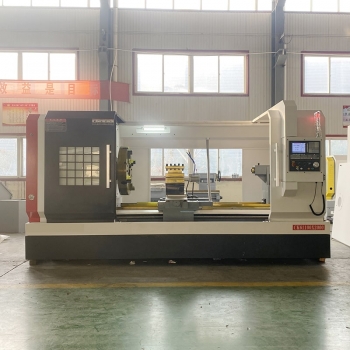
Flat bed cnc lathe machine ALCK6150X1000 machinable screws
Product Description
The cnc mini metal lathe machine can not only turn any straight, taper and face threads with constant lead, but also can turn threads with smooth transition between variable lead and variable lead.
When CNC lathe turning is turning threads, the spindle direction does not need to be alternated like ordinary lathes. It can cycle one knife after another without stopping until it is completed, so the efficiency of CNC horizontal lathe is very high.


Product Features:
●High processing precision and stable processing quality;
●Multi-coordinate linkage is possible, and parts with complex shapes can be processed;
●When the processing parts are changed, generally only the NC program needs to be changed, which can save production preparation time;
●Cnc lathe fanuc itself has high precision and high rigidity, can choose favorable processing dosage, and has high productivity (generally 3 to 5 times that of ordinary machine tools);
●Automatic cnc lathe has a high degree of automation, which can reduce labor intensity;
●Higher quality requirements for operators and higher technical requirements for maintenance personnel.


Technical Parameters

#cnc #lathe #Hass #Mazzak #cnclathe #cnclathe #metalcnclathe #cnclathemachine #flatbedcnclathe #cnclatheturning #minicnclathemachine #cnclathefanuc #horizontalcnclathe #minicnclathe #highprecisioncnclathe #flatbedcnclathemachine #cnclathemanufacture

The workflow of high precision cnc lathe:
1. Analyze the part drawing: compare the specification, performance and function of the flat bed cnc lathe machine with the geometry and size of the part to judge whether it meets the requirements.
2. Process analysis: In the process of cnc lathe manufacture, it cannot be manually adjusted like ordinary machine tools, so an economical and reasonable process plan must be formulated in advance. The cnc lathe machine mainly includes the determination of parts positioning and fixtures, processing sequences, tool paths, cutting tools, cutting parameters, heat treatment methods, calibration and auxiliary processes.
3. Mathematical processing of graphics: establish the workpiece coordinate system and perform necessary calculations, such as obtaining the coordinates of the center point and end point. For some relatively backward cnc lathe, it may also be necessary to manually calculate sharp corner transitions, etc.

4. Programming: The program is a process described according to the digital representation provided by the mini cnc lathe machine, which is called processing code or G code. Details will be covered in the next section.
5. Program verification and trial cutting: In general, first check whether the tool trajectory is correct during the simulation process, then idle to observe whether the tool movement is normal, and finally clamp the workpiece for trial cutting.
6. Modification confirmation: modify the problems exposed during the verification process.
7. For complex parts, cad/cam software is usually used to analyze part drawings, process analysis, mathematical processing and programming of graphics. Due to the different definitions of G codes in different CNC systems, it is necessary to select the corresponding post-processor in the cad/cam software to complete the generation of G codes.
Video
Technical Parameters

#cnc #lathe #Hass #Mazzak #cnclathe #cnclathe #metalcnclathe #cnclathemachine #flatbedcnclathe #cnclatheturning #minicnclathemachine #cnclathefanuc #horizontalcnclathe #minicnclathe #highprecisioncnclathe #flatbedcnclathemachine #cnclathemanufacture
You May Also Like


China CNC Milling Machine VMC1580 Fanuc CNC Controller VMC Machine
China CNC Milling Machine VMC1580 Fanuc CNC Controller VMC Machine… Read More


